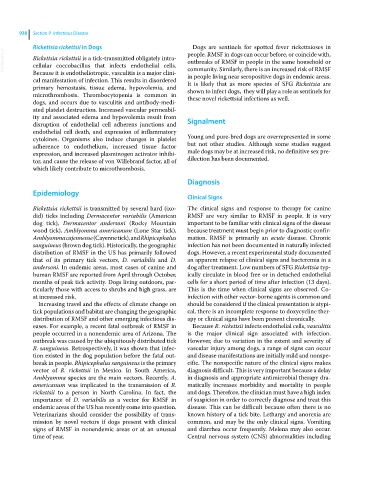Page 1000 - Clinical Small Animal Internal Medicine
P. 1000
938 Section 9 Infectious Disease
Rickettsia rickettsii in Dogs Dogs are sentinels for spotted fever rickettsioses in
VetBooks.ir Rickettsia rickettsii is a tick‐transmitted obligately intra- people. RMSF in dogs can occur before, or coincide with,
outbreaks of RMSF in people in the same household or
cellular coccobacillus that infects endothelial cells.
Because it is endotheliotropic, vasculitis is a major clini- community. Similarly, there is an increased risk of RMSF
in people living near seropositive dogs in endemic areas.
cal manifestation of infection. This results in disordered It is likely that as more species of SFG Rickettsia are
primary hemostasis, tissue edema, hypovolemia, and shown to infect dogs, they will play a role as sentinels for
microthrombosis. Thrombocytopenia is common in these novel rickettsial infections as well.
dogs, and occurs due to vasculitis and antibody‐medi-
ated platelet destruction. Increased vascular permeabil-
ity and associated edema and hypovolemia result from
disruption of endothelial cell adherens junctions and Signalment
endothelial cell death, and expression of inflammatory
cytokines. Organisms also induce changes in platelet Young and pure‐bred dogs are overrepresented in some
adherence to endothelium, increased tissue factor but not other studies. Although some studies suggest
expression, and increased plasminogen activator inhibi- male dogs may be at increased risk, no definitive sex pre-
tor, and cause the release of von Willebrand factor, all of dilection has been documented.
which likely contribute to microthrombosis.
Diagnosis
Epidemiology
Clinical Signs
Rickettsia rickettsii is transmitted by several hard (ixo- The clinical signs and response to therapy for canine
did) ticks including Dermacentor variabilis (American RMSF are very similar to RMSF in people. It is very
dog tick), Dermacentor andersoni (Rocky Mountain important to be familiar with clinical signs of the disease
wood tick), Amblyomma americanum (Lone Star tick), because treatment must begin prior to diagnostic confir-
Amblyomma cajennense (Cayenne tick), and Rhipicephalus mation. RMSF is primarily an acute disease. Chronic
sanguineus (brown dog tick). Historically, the geographic infection has not been documented in naturally infected
distribution of RMSF in the US has primarily followed dogs. However, a recent experimental study documented
that of its primary tick vectors, D. variabilis and D. an apparent relapse of clinical signs and bacteremia in a
andersoni. In endemic areas, most cases of canine and dog after treatment. Low numbers of SFG Rickettsia typ-
human RMSF are reported from April through October, ically circulate in blood free or in detached endothelial
months of peak tick activity. Dogs living outdoors, par- cells for a short period of time after infection (13 days).
ticularly those with access to shrubs and high grass, are This is the time when clinical signs are observed. Co‐
at increased risk. infection with other vector‐borne agents is common and
Increasing travel and the effects of climate change on should be considered if the clinical presentation is atypi-
tick populations and habitat are changing the geographic cal, there is an incomplete response to doxycycline ther-
distribution of RMSF and other emerging infectious dis- apy or clinical signs have been present chronically.
eases. For example, a recent fatal outbreak of RMSF in Because R. rickettsii infects endothelial cells, vasculitis
people occurred in a nonendemic area of Arizona. The is the major clinical sign associated with infection.
outbreak was caused by the ubiquitously distributed tick However, due to variation in the extent and severity of
R. sanguineus. Retrospectively, it was shown that infec- vascular injury among dogs, a range of signs can occur
tion existed in the dog population before the fatal out- and disease manifestations are initially mild and nonspe-
break in people. Rhipicephalus sanguineus is the primary cific. The nonspecific nature of the clinical signs makes
vector of R. rickettsii in Mexico. In South America, diagnosis difficult. This is very important because a delay
Amblyomma species are the main vectors. Recently, A. in diagnosis and appropriate antimicrobial therapy dra-
americanum was implicated in the transmission of R. matically increases morbidity and mortality in people
rickettsii to a person in North Carolina. In fact, the and dogs. Therefore, the clinician must have a high index
importance of D. variabilis as a vector for RMSF in of suspicion in order to correctly diagnose and treat this
endemic areas of the US has recently come into question. disease. This can be difficult because often there is no
Veterinarians should consider the possibility of trans- known history of a tick bite. Lethargy and anorexia are
mission by novel vectors if dogs present with clinical common, and may be the only clinical signs. Vomiting
signs of RMSF in nonendemic areas or at an unusual and diarrhea occur frequently. Melena may also occur.
time of year. Central nervous system (CNS) abnormalities including

